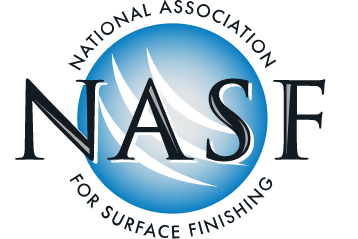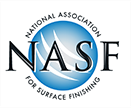NASF Public Policy Update | January 2021
The National Association for Surface Finishing (NASF) offers its public policy update for January 2021 to the finishing industry.

The National Association for Surface Finishing (NASF, Washington, D.C.) has released its Public Policy update for January 2021. NASF regularly releases public policy updates for its members, but this ipdate is being made available to the larger finishing industry. Anyone can access the full NASF January 2021 Public Policy Update here.
Here are some highlights:
The incoming Biden administration and Georgia runoff election may shift environmental policy and chemicals policy (including PFAS regulation). NASF suspects environmental justice and climate change will be at the top of the agenda, as well as new initiatives on the labor, health and safety, tax, trade and other fronts.
The EPA has released updated 2019 Toxics Release Inventory (TRI) data that includes summary and trend information, but does not include EPA's full analysis of the 2019 data. The 2019 TRI National Analysis, to be published in early 2021, will examine different aspects of the data, including trends in releases, other waste management practices, and pollution prevention activities.
In March 2020, the EPA published its proposed 2020 National Pollutant Discharge Elimination System (NPDES) Multi-Sector General Permit (MSGP) that authorizes stormwater discharges associated with industrial activity in areas where EPA is the NPDES permitting authority. NASF has submitted comments on the proposed MSGP.
The EPA identified n-propyl bromide (1-bromopropane) as one of its first ten high priority chemicals under the Toxic Substances Control Act (TSCA). N-propyl bromide is used as a solvent to clean parts prior to surface finishing. EPA has one year from the risk evaluation to issue a proposed rule and two years from the risk evaluation to issue a final rule. NASF as well as a few of its members have been invited to participate in the Small Business Regulatory Enforcement Fairness Act (SBREFA) panel as small entity representatives (SERs).
EPA has also identified trichloroethylene (TCE) as one of its first ten high priority chemicals under the Toxic Substances Control Act (TSCA). TCE has been used as a solvent to clean parts prior to surface finishing.
NASF, with the assistance of Dr. Janet Anderson, developed a PFAS Sampling and Analysis Plan (SAP) for NASF members.
In 2020, the EPA proposed a regulatory determination to regulate PFOS and PFOA in drinking water. This is the first step in the regulatory process to establish a federal drinking water standard for PFOS and PFOA. NASF has encouraged the EPA to consider a treatment-focused regulatory approach to a drinking water standard for PFOS and PFOA, and that the treatment technologies considered must be technologically and economically feasible, consistent with the SDWA.
In 2020, the EPA issued a final significant new use rule (SNUR) for long-chain perfluoroalkyl carboxylate (LCPFAC) chemical substances that imposes notification and other regulatory requirements on the manufacture, import or processing of certain new uses of specified LCPFAC substances, including PFOA and its salts. This SNUR does include PFOS or 6:2 FTS, the substances used in fume suppressants in the surface finishing industry. Accordingly, the article exemption for PFOS and 6:2 FTS would not be impacted by this SNUR.
EPA has published the draft Interim Guidance on Destroying and Disposing of Certain PFAS and PFAS-Containing Materials That Are Not Consumer Products with a 60-day public comment period under docket EPA-HQ-OLEM-2020-0527.
EPA Region 5, EPA Office of Research and Development (ORD) and the Michigan Department of Environment, Great Lakes and Energy (EGLE) conducted PFAS testing of fume suppressants currently in use and effluent discharge at approximately 12 plating shops in Michigan. The goal of this project was to determine if any PFOS is present in the fume suppressant currently in use and which PFAS, if any, may be in the effluent discharges of finishing shops.
On September 24, 2020, the Michigan Department of Environment, Great Lakes, and Energy (EGLE), Air Quality Division issued an initial threshold screening level (ITSL) for air emissions of 6:2 fluorotelomer sulfonate (or 6:2 FTS) of 1 μg/m³, with annual averaging time. 6:2 FTS is used in the current formulations of fume suppressants for chrome plating applications.
NASF and the AESF Foundation have joined the Water and Environmental Technology (WET) Center Industrial Advisory Board, which focuses on a broad range of water and wastewater technologies and related public health issues.
To get more information on any of the stories mentioned above, access the full NASF Public Policy Update for January 2021.
 This article is courtesy of the Products Finishing and National Association for Surface Finishing (NASF) media partnership. For more information or to become a member, visit nasf.org.
This article is courtesy of the Products Finishing and National Association for Surface Finishing (NASF) media partnership. For more information or to become a member, visit nasf.org.
Related Content
NASF/AESF Foundation Research Project #123: Electrochemical Manufacturing for Energy Applications – 4th and 5th Quarter Report
The NASF-AESF Foundation Research Board selected a project on electrodeposition toward developing low-cost and scalable manufacturing processes for hydrogen fuel cells and electrolysis cells for clean transportation and distributed power applications. During the reporting period, efforts were focused on planning the overall project work, with the eventual goal of manufacturing an improved design for a Solid oxide fuel cell anode supported flat tube (SOFC).
Read MoreNASF/AESF Foundation Research Project #120: Electrochemical Destruction of Perfluorooctanesulfonate in Electroplating Wastewaters – 7th & 8th Quarter Report
This NASF-AESF Foundation research project report covers the seventh and eighth quarters of project work (October 2021-March 2022) at the University of Illinois at Chicago. The major activities reported are: (1) to investigate 6:2 FTS oxidation, a common replacement compound for PFOS in the electroplating industry, and (2) PFAS oxidation in both a wastewater sample procured from an electroplating facility and in synthetic solutions.
Read MoreSmart Modeling and Simulation of Electroplating Systems for Real-Time Monitoring of Chemical, Water and Energy Consumption (NASF Summer Research Grant)
An AESF Foundation summer research grant provided an excellent opportunity for a PhD student to learn how to use chemical engineering fundamentals to scientifically characterize an electroplating process through integrated dynamic modeling and simulation, and how to develop digital twin (DT)-based virtual plant that can be of any process configuration. This is a critical step for the investigation of new technology development for smart and sustainable manufacturing in the surface finishing industry.
Read MoreNanostructure of the Anodic and Nanomaterials Nanoparticles in Polyelectrolyte Multilayer-by-Layer (LbL) Films
Microstructure and elemental characterizations have indicated that the finish of a coating with a Layer-by-Layer (LbL) film results in a closely multilayered coating with a smoother surface. In this paper, the principles of assembly are discussed together with the properties of nanoparticles and LbL polymeric assembly essential in building hybrid coatings.
Read MoreRead Next
The 2024 Ford Mustang: All the Colors Available
Although Chevrolet has announced the end of the Camaro and Dodge is offering “Last Call” editions of the Charger and Challenger, the Ford Mustang is launching to its seventh generation.
Read MorePowder Coating 4.0: Smarter, Faster, More Efficient and Connected
New tools reduce cost and waste, lower manufacturing footprint of powder coating operations.
Read MoreEpisode 42: An Interview with Robin Deal, Hubbard-Hall
Hubbard-Hall wastewater treatment specialist Robin Deal discusses the latest trends in wastewater management.
Read More

























